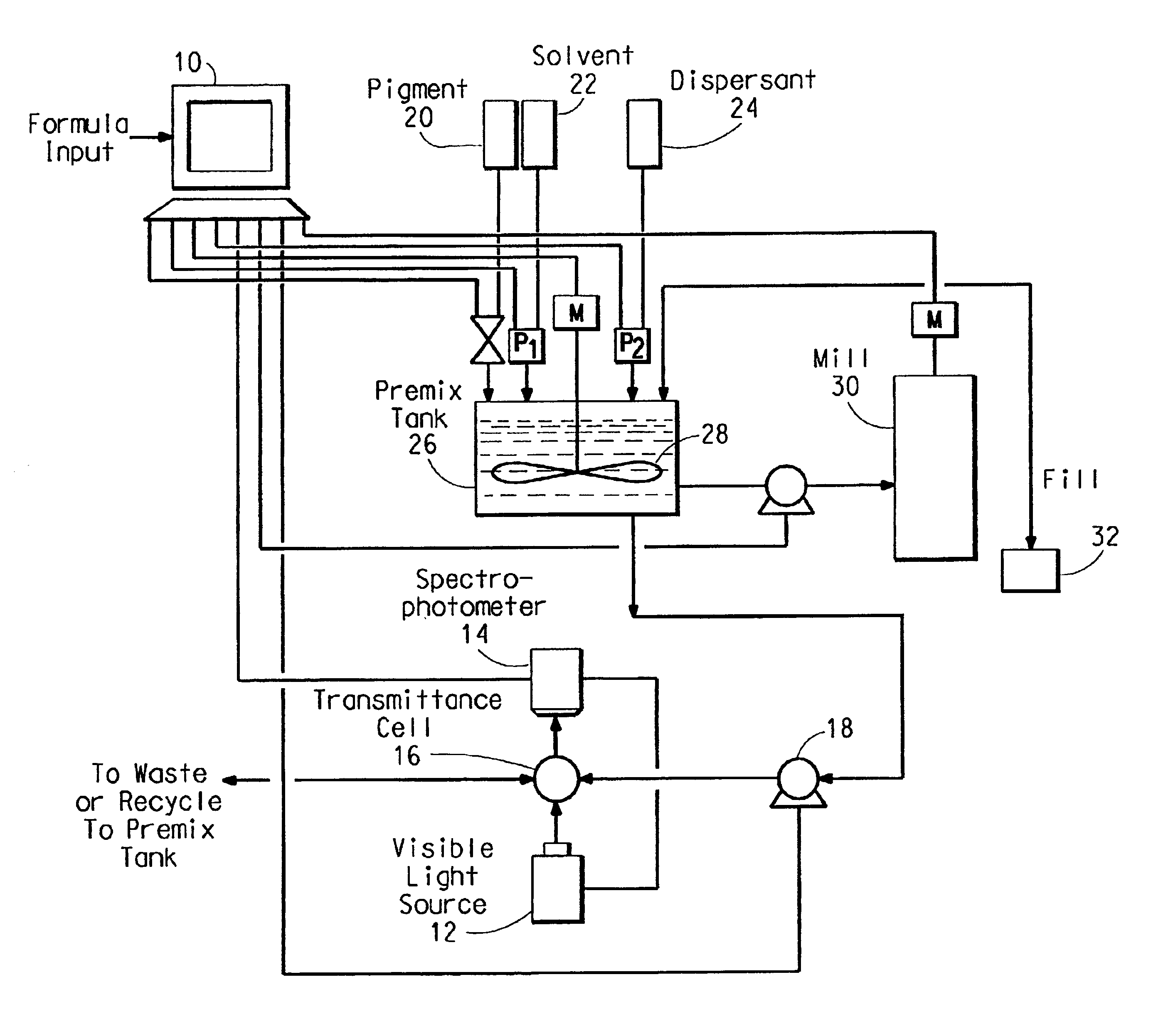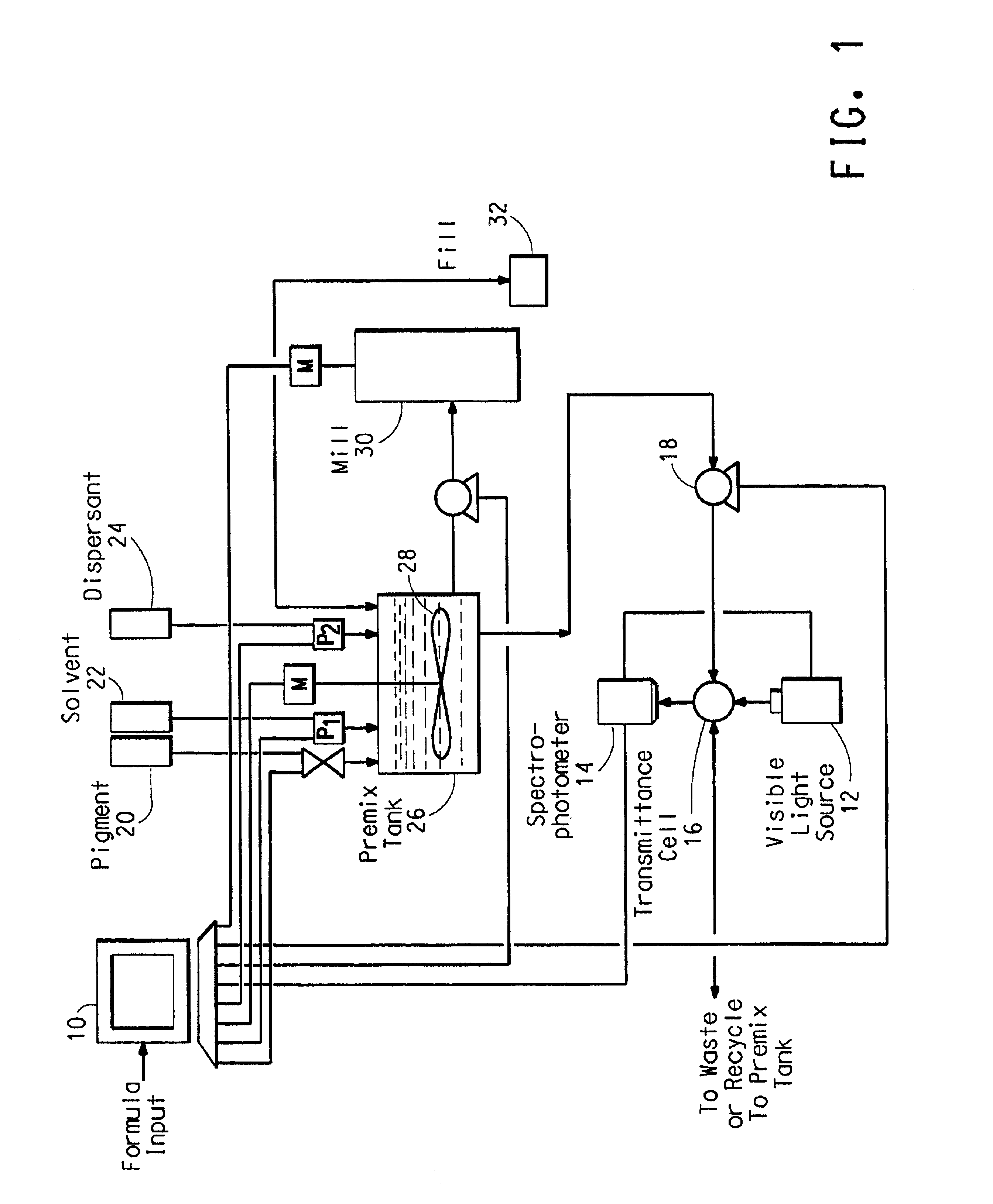Process for manufacturing pigment dispersions
- Summary
- Abstract
- Description
- Claims
- Application Information
AI Technical Summary
Benefits of technology
Problems solved by technology
Method used
Image
Examples
example 1
[0053]The process described above was operated in off-line mode to characterize a single-pigment green dispersion. The dispersion was produced by grinding a mixture of green pigment, polymeric dispersant and solvent in a sand mill in a pass-to-pass operation. The batch was purposely ground for extra passes to provide samples on either side of the standard dispersion. Batch samples were taken after the 2nd, 3rd, 4th and 5th passes and tested for particle size.
[0054]In the dry test, dry drawdowns of the neat samples were used for transparency comparisons to the standard dispersions. In the wet test, the ratios of optical density (O.D.) at 530 nm and 560 nm were measured on neat liquid dispersions samples. 530 nm was chosen because it was the wavelength of peak transmittance, while 560 nm, although not the point of maximum absorbance, was selected because it provided an accurate high absorbance data point. For the wet transmittance measurements, optical pathlength was set at 38 microns...
example 2
[0058]The dispersion samples from Example 1 above were tested for tinting strength, using dry and wet techniques. Dry results were gathered using the traditional method of mixing the dispersion with a white paint, spraying onto panels, baking the panels and measuring the lightness values (L*) of the dry panels versus a standard. Wet optical density measurements were taken as described in Example 1.
[0059]
WetDry ΔL*O.D.(530 nm) / O.D.(560 nm) Standard Dispersion 0.000.5162nd Pass 0.300.5433rd Pass−0.160.4884th Pass−0.160.4765th Pass−0.280.472
[0060]The wet O.D. ratios corresponded well to the dry tinting strength measurements, indicating the effectiveness of the wet method in predicting strength. The wet measurements also showed the expected increase in strength between the 3rd and 4th passes, while the dry test did not. When compared to the standard dispersion, the wet measurements would have indicated that strength was sufficiently developed after the 3rd pass.
example 3
[0061]The dispersion samples from Example 1 above were diluted with a clear binder / solvent blend at a ratio of 33 grams of clear per 100 grams of dispersion. The diluted samples were then measured in wet transmittance as described above and the optical density ratios calculated at the selected wavelengths of 530 nm and 560 nm. In addition, optical densities of the neat samples were compared to those of the diluted samples at peak transmittance to determine whether Beer's law held over this concentration range.
[0062]The wet optical density ratios were measured as follows:
[0063]
DiluteNeatO.D.(530 nm) / O.D.(530 nm) / Neat / DiluteO.D.(560 nm)O.D.(560 nm)O.D. @ 530 nm 2nd Pass 0.5430.5431.343rd Pass0.4920.4881.344th Pass0.4800.4761.335th Pass0.4700.4721.33
[0064]The data show that, within measurement error, the O.D. ratios indicating particle size do not change over a significant concentration range, and that O.D. at peak transmittance provides an accurate measure of relative concentration. ...
PUM
| Property | Measurement | Unit |
|---|---|---|
| Nanoscale particle size | aaaaa | aaaaa |
| Nanoscale particle size | aaaaa | aaaaa |
| Nanoscale particle size | aaaaa | aaaaa |
Abstract
Description
Claims
Application Information
 Login to View More
Login to View More - R&D
- Intellectual Property
- Life Sciences
- Materials
- Tech Scout
- Unparalleled Data Quality
- Higher Quality Content
- 60% Fewer Hallucinations
Browse by: Latest US Patents, China's latest patents, Technical Efficacy Thesaurus, Application Domain, Technology Topic, Popular Technical Reports.
© 2025 PatSnap. All rights reserved.Legal|Privacy policy|Modern Slavery Act Transparency Statement|Sitemap|About US| Contact US: help@patsnap.com


